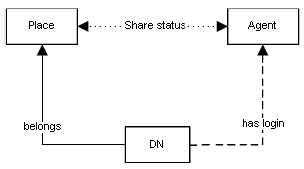A Recounting of Action Propagation
Stat Server uses an object-centric model to provide statistics for contact center objects. You define and configure the objects that Stat Server monitors within Configuration Server; Stat Server generates actions that report contact center events occurring at these objects. Parent-child relationships can exist between many of these objects where the objects belong to the same compatibility group. Some of these relationships are static—that is, the relationships are defined in configuration. Other parent-child relationships are dynamic, such as the relationship that results when a contact center agent (represented by a Person object in Configuration Server) logs in to a DN (represented by a RegDN object). The chain of parent-child associations forms a hierarchy, which is illustrated in Hierarchy of Stat Server Telephony Objects.
Stat Server begins by generating all applicable actions for objects that have no children, such as DNs. Stat Server uses these generated actions to compute an object’s status. A DN’s status, for example, is computed by identifying the highest-priority action occurring at the DN. Stat Server then propagates all of the actions and statuses generated for the child object to its parent objects. Durations are adjusted to reflect the duration of the association between parent and child.

To illustrate this adjustment, consider the following:
Agent answers a customer call on DN and converses with the customer for one hour. Halfway through the call, Agent logs in to Place. Stat Server generates the CallInbound action for DN and propagates this action to its parent Place and Person objects.
However, Stat Server must adjust the duration of the propagated CallInbound action for Agent to 30 minutes, because Agent was associated with neither Place nor DN during the first half of the call.
For objects that do have children, Stat Server computes status based on the status of the objects’ children (adjusted as described above). For additional information on this object-specific algorithm, refer to:
